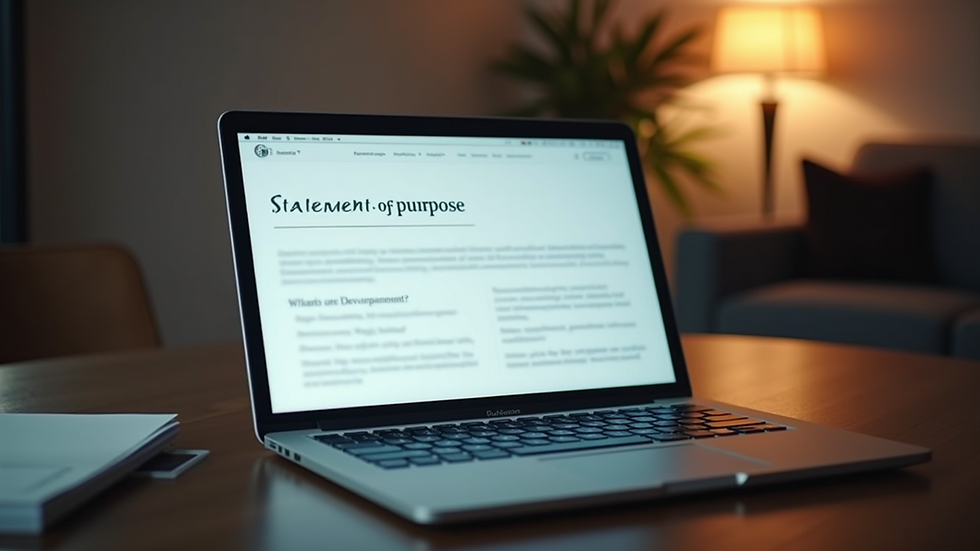
Mastering the Art of Writing a Statement of Purpose
- Mati Lio
- Aug 13
- 5 min read
Writing a Statement of Purpose (SOP) can feel like a daunting task. It’s your chance to tell your story, showcase your ambitions, and convince an admissions committee or employer that you’re the perfect fit. But where do you start? How do you make your SOP stand out without sounding like everyone else? Don’t worry! I’m here to guide you through the process with practical advice, clear examples, and a friendly tone. Together, we’ll master the art of writing a statement of purpose that truly shines.
SOP Writing Tips to Get You Started
Let’s kick things off with some essential tips that will set you on the right path. Writing an SOP isn’t just about listing your achievements or repeating your resume. It’s about crafting a compelling narrative that connects your past experiences, present goals, and future aspirations.
Be authentic: Admissions officers want to hear your voice. Don’t try to sound overly formal or use complicated words just to impress. Keep it natural and sincere.
Start with a hook: Grab attention right away. Maybe a brief story, a defining moment, or a bold statement about your passion.
Show, don’t just tell: Instead of saying “I am passionate about biology,” describe a project or experience that ignited that passion.
Be specific: Avoid vague statements. Instead of “I want to learn more,” say “I want to deepen my understanding of molecular genetics to contribute to cancer research.”
Keep it focused: Stick to the word limit and avoid unnecessary details. Every sentence should add value.
Proofread and edit: Typos and grammatical errors can ruin your impression. Read your SOP multiple times and ask someone else to review it.
Remember, your SOP is your personal story. It’s your chance to connect with the reader on a human level. So, don’t be afraid to let your enthusiasm and personality shine through!

Understanding the Purpose Behind Your Statement
Before diving into writing, it’s crucial to understand why you’re writing an SOP. This document is more than just a formality. It’s a window into your motivations, your academic and professional journey, and your future plans.
Think of it this way: the admissions committee or employer is trying to answer three key questions about you:
Who are you? What makes you unique? What experiences have shaped you?
Why this program or position? How does it align with your goals?
What will you contribute? How will you add value to their community or organization?
Answering these questions clearly and confidently will make your SOP compelling. It’s not just about what you want, but also about what you bring to the table.
For example, if you’re applying for a graduate program in environmental science, don’t just say you care about the environment. Share a story about a community project you led or a research paper you wrote that demonstrates your commitment and skills.
What is the format of statement of purpose?
Knowing the right format can make your SOP easier to read and more professional. While there’s no one-size-fits-all template, most SOPs follow a similar structure:
1. Introduction
Start with a hook or a brief story.
State your purpose for applying.
Give a snapshot of your background.
2. Academic and Professional Background
Highlight relevant education and experiences.
Mention key achievements or projects.
Explain how these experiences prepared you for the program or role.
3. Your Goals and Motivation
Describe your short-term and long-term goals.
Explain why this program or position is essential for your growth.
Connect your goals with the institution’s strengths or values.
4. Why This Institution or Organization?
Show that you’ve researched the program or company.
Mention specific faculty, courses, or values that attract you.
Explain how you fit into their community.
5. Conclusion
Summarize your key points.
Reaffirm your enthusiasm and readiness.
End on a positive, forward-looking note.
Keep paragraphs short and focused. Use clear transitions to guide the reader smoothly from one section to the next. And remember, your SOP should ideally be between 500 and 1000 words unless otherwise specified.

Crafting Your Story: Tips for Each Section
Let’s break down each part of your SOP with actionable advice and examples.
Introduction: Make It Memorable
Your opening lines set the tone. Avoid clichés like “Since I was a child…” Instead, try something like:
“The moment I peered through a microscope and saw the intricate dance of cells, I knew biology was my calling.”
“Volunteering at a refugee centre opened my eyes to the power of education in transforming lives.”
This draws the reader in and makes them want to learn more.
Academic and Professional Background: Be Relevant
Focus on experiences that relate directly to your goals. For instance:
“During my undergraduate studies in computer science, I developed a mobile app that helps visually impaired users navigate public spaces.”
“My internship at XYZ NGO taught me the importance of community engagement in sustainable development.”
Use numbers or outcomes when possible: “The app was downloaded over 5,000 times in six months.”
Goals and Motivation: Be Clear and Ambitious
Don’t be vague. Instead of “I want to learn more about business,” say:
“I aim to specialize in international marketing to help Canadian companies expand into global markets.”
Show how your goals align with your background and the program’s offerings.
Why This Institution or Organization? Show You’ve Done Your Homework
Mention specific professors, courses, or projects that excite you. For example:
“I am particularly drawn to Professor Smith’s research on renewable energy, which aligns with my passion for sustainable solutions.”
“The university’s emphasis on experiential learning matches my hands-on approach to education.”
This shows genuine interest and effort.
Conclusion: End Strong
Wrap up by summarizing your enthusiasm and readiness:
“I am eager to contribute my skills and passion to your program and grow into a leader who drives positive change.”
“Thank you for considering my application. I look forward to the opportunity to learn and collaborate with your esteemed faculty.”

Final Thoughts on Perfecting Your SOP
Writing a statement of purpose is a journey of self-discovery and communication. It’s your chance to tell your story in a way that resonates and inspires. If you’re wondering how to write a statement of purpose that truly stands out, consider seeking expert guidance. There are resources and services designed to help you craft a polished, impactful SOP that reflects your unique voice and goals.
Remember, your SOP is more than just words on a page. It’s your first impression, your personal pitch, and your bridge to new opportunities. Take your time, be honest, and don’t hesitate to revise until it feels just right.
Ready to get started? Dive in with confidence, and watch your story open doors you never imagined!
If you want to explore more about how to write a statement of purpose, check out this helpful resource for detailed guidance and support.



Comments